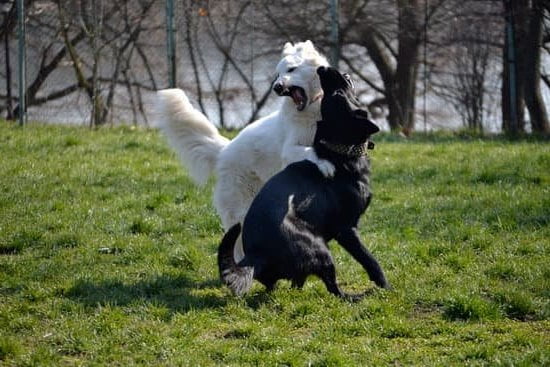When it comes to training a puppy to be a service dog, it is essential to understand the vital role that these specially trained animals play in the lives of individuals with disabilities. From guiding the visually impaired to providing emotional support for those struggling with mental health issues, service dogs are dedicated companions that enhance the quality of life for their owners.
In this article, we will explore the process of how to train a puppy to be a service dog, from selecting the right breed and puppy to mastering basic and advanced training techniques.
Service dogs undergo rigorous training that goes beyond simple obedience commands. They are taught specific tasks tailored to meet the needs of their individual owners, such as retrieving items, alerting to medical conditions, and providing stability and balance for mobility-impaired individuals.
The bond between a service dog and its owner is built on trust, teamwork, and mutual respect. By understanding the unique responsibilities of a service dog, trainers can provide the necessary skills and support for these special animals to excel in their roles.
Choosing the right breed and puppy for service dog training is crucial in setting them up for success. Different breeds have inherent traits that make them more suitable for certain tasks or environments.
It is essential to consider factors such as temperament, energy level, size, and trainability when selecting a potential candidate for service dog training. With proper guidance and dedication from trainers, puppies can develop into reliable service dogs that make a positive impact on the lives of their handlers.
The Importance of Proper Training for Service Dogs
Proper training for service dogs is essential to ensure their efficiency and effectiveness in assisting individuals with disabilities. Training a puppy to become a service dog requires time, dedication, and patience. It is crucial to understand that service dogs play a vital role in the lives of their owners, providing them with independence, support, and companionship. Therefore, investing in thorough training for your puppy is crucial in preparing them for their future responsibilities.
Training Techniques
When training a puppy to be a service dog, it is important to use positive reinforcement techniques such as treats, praise, and rewards. This method helps the puppy associate good behavior with positive outcomes, making the learning process more effective and enjoyable. Consistency is key when implementing training techniques, ensuring that the puppy understands commands and behaviors consistently across different environments.
Building Trust and Confidence
Building trust and confidence between the puppy and its trainer is fundamental during the training process. Service dogs need to be reliable in various situations, including crowded spaces, loud noises, and unfamiliar surroundings. By establishing a strong bond based on trust and respect, the puppy will develop into a confident and capable service dog. Regular training sessions that focus on building communication skills and obedience are essential for developing this bond.
Professional Guidance
While training a puppy to be a service dog can be challenging, seeking professional guidance from experienced trainers or organizations specializing in service dog training can provide valuable support. These experts can offer personalized advice, resources, and strategies tailored to your specific needs and goals when training your puppy. Additionally, participating in group classes or workshops dedicated to service dog training can offer socialization opportunities for your puppy while also enhancing their learning experience.
By understanding the importance of proper training for service dogs and implementing effective techniques such as positive reinforcement, trust-building exercises, and seeking professional guidance when needed, you can successfully train your puppy to become an invaluable companion for individuals with disabilities. Remember that patience, consistency, and dedication are key components of developing a well-trained service dog ready to assist their owner in various tasks and situations.
Choosing the Right Breed and Puppy for Service Dog Training
When it comes to training a puppy to be a service dog, selecting the right breed and individual puppy is crucial for success. Not all dogs are suitable for service work, as certain breeds possess characteristics that make them more ideal candidates. Here are some factors to consider when choosing the right breed and puppy for service dog training:
- Temperament: Look for breeds known for their calm demeanor, intelligence, and eagerness to please. This will make training easier and increase the likelihood of successful outcomes.
- Size: The size of the breed should match the tasks the service dog will be trained to perform. For example, larger breeds may be better suited for tasks requiring strength or mobility assistance.
- Health: Ensure that the breed you choose is generally healthy and free from genetic health issues that could impact their ability to perform as a service dog.
In addition to selecting the right breed, choosing an individual puppy with the appropriate temperament and potential for success in service work is essential. Look for puppies that exhibit curiosity, willingness to learn, and a strong bond with humans. Early socialization and exposure to different environments can also play a significant role in shaping a puppy’s development as a future service dog.
- To evaluate a potential puppy candidate, observe how they interact with their littermates, humans, and new experiences.
- Look for signs of confidence, adaptability, and intelligence in their behavior.
- Consider working with reputable breeders or rescue organizations experienced in breeding and training dogs for service work.
By carefully choosing both the breed and individual puppy for service dog training, you set a solid foundation for success in developing a reliable and dedicated service companion. Working with professionals or trainers who specialize in this area can also provide valuable guidance on how to train your puppy effectively towards becoming an invaluable service dog.
Basic Training Commands for Service Dog Candidates
Training a puppy to be a service dog requires dedication, patience, and consistency. Basic training commands are essential building blocks for the development of a successful service dog candidate. These commands not only lay the foundation for more advanced tasks but also help instill discipline and focus in your furry companion.
As their nose follows the treat, their bottom should naturally lower to the ground. Once they are in a sitting position, reward them with the treat and praise.
Another crucial command is “stay,” which is essential for service dogs who need to remain in one spot for extended periods. Begin by having your puppy sit, then hold out your hand in front of them with an open palm and say “stay” in a firm but gentle tone. Take a step back while maintaining eye contact with your pup.
If they stay put, return immediately, reward them with a treat, and provide verbal praise. Gradually increase the distance and duration of the stay command as your puppy becomes more comfortable with this concept.
You can encourage them further by patting your legs or showing them a favorite toy. When they approach you successfully, reward them generously with treats and praise to reinforce this behavior. Practice this command regularly in different environments to ensure reliability from your service dog candidate.
| Basic Command | Description |
|---|---|
| Sit | Teaches impulse control and calm behavior. |
| Stay | Helps dogs remain in one place for extended periods. |
| Come | Ensures prompt response when called, important for emergencies. |
Advanced Training Techniques for Service Dog Candidates
For a puppy to become a successful service dog, it must undergo advanced training techniques that go beyond basic commands. One key aspect of this stage is task-specific training, where the dog learns skills tailored to the needs of its future owner. This can include tasks like retrieving specific items, providing physical support for balance, or recognizing and responding to medical emergencies. These tasks are crucial in helping individuals with disabilities lead more independent lives.
Another important advanced training technique is obedience training in distracting environments. Service dogs need to remain focused on their tasks even in noisy or crowded places. Exposing them to different environments such as malls, parks, and public transportation helps build their confidence and ability to perform effectively in real-world situations. Consistent practice in varied settings is essential to ensure that the service dog can reliably assist its handler whenever needed.
Furthermore, advanced training techniques for service dog candidates often incorporate impulse control exercises. Dogs must learn how to resist distractions, ignore potential threats, and maintain composure in high-stress situations. Teaching them self-control allows them to stay calm and composed during emergencies or challenging circumstances. Through positive reinforcement methods and consistent practice, trainers can help service dogs develop the necessary discipline and focus required for their important role.
| Key Aspect | Details |
|---|---|
| Task-specific Training | Puppies learn skills tailored to the needs of their future owners. |
| Obedience Training | Dogs are trained to remain focused in distracting environments such as malls and parks. |
| Impulse Control Exercises | Teaching dogs self-control for remaining composed during emergencies or stressful situations. |
Socialization and Exposure to Different Environments
Introduction to Socialization and Exposure
Socialization and exposure to different environments are crucial aspects of training a puppy to become a service dog. It is essential for service dogs to be comfortable and confident in various settings, as they may need to accompany their owners to different locations and situations. Proper socialization ensures that the service dog can interact positively with people, animals, and objects in a calm and controlled manner.
Gradual Introduction to Different Environments
When training a puppy to be a service dog, it is important to gradually expose them to different environments and stimuli. Start by introducing the puppy to new places with minimal distractions, such as quiet parks or empty sidewalks. As the puppy becomes more comfortable, slowly increase the level of exposure by visiting busier areas, pet-friendly stores, or even public transportation.
Positive Reinforcement and Desensitization Techniques
Using positive reinforcement techniques during socialization and exposure training can help the puppy associate new environments with positive experiences. Rewarding good behavior with treats, praise, or toys can encourage the puppy to feel confident and relaxed in unfamiliar surroundings. Additionally, desensitization techniques can be used to help the puppy overcome any fears or anxieties they may have about certain environments or stimuli.
By following these socialization and exposure guidelines during the training process, owners can help prepare their puppies for the responsibilities of being a service dog. This foundation will not only benefit the service dog but also strengthen the bond between the dog and its owner as they navigate different environments together.
Handling Common Challenges and Behavioral Issues During Training
Training a puppy to become a service dog can be a rewarding but challenging process. During the training journey, it is common to encounter various challenges and behavioral issues that may hinder progress. Learning how to address these issues effectively is essential in ensuring the success of the training program. Here are some common challenges and behavioral issues that may arise during the training of a service dog candidate, along with tips on how to handle them:
- Housebreaking: One of the most common challenges in training a service dog puppy is housebreaking. Puppies may have accidents indoors, which can be frustrating for both the trainer and the puppy. To address this issue, establish a consistent schedule for potty breaks and reward the puppy for going outside. Use positive reinforcement techniques such as treats and praise to encourage good behavior.
- Destructive Behavior: Another challenge that trainers may face is destructive behavior, such as chewing on furniture or shoes. To prevent this, provide the puppy with appropriate chew toys and redirect their attention when they start chewing on inappropriate items. Consistency and patience are key in addressing destructive behaviors.
- Distraction: Service dogs need to stay focused on their tasks, even in distracting environments. Some puppies may struggle with distractions, making it difficult to maintain their focus during training sessions. To help your puppy stay focused, gradually expose them to different environments and distractions while practicing commands. Start in a quiet setting and gradually increase the level of distraction as your puppy progresses.
Dealing with these challenges requires patience, consistency, and understanding of your puppy’s individual needs. Remember that every puppy is unique and may require different approaches to training. By addressing these common challenges effectively, you can help your puppy develop into a confident and well-trained service dog that will make a positive impact on someone’s life.
Certification and Accreditation Process for Service Dogs
When it comes to training a puppy to become a service dog, certification and accreditation are essential steps in ensuring that the dog is qualified and capable of providing assistance to its owner. The process of certifying and accrediting a service dog involves rigorous evaluations to assess the dog’s skills, behavior, and obedience. This ensures that the service dog is reliable, well-behaved, and able to perform tasks that support its owner’s needs.
One of the first steps in the certification process for a service dog is completing basic obedience training. This includes teaching the puppy essential commands such as sit, stay, come, heel, and down. These foundational commands are crucial for building a strong training foundation for the service dog candidate. Additionally, basic obedience training helps establish a bond between the puppy and its trainer, laying the groundwork for more advanced training later on.
After mastering basic obedience commands, the service dog candidate will need to undergo more advanced training techniques to prepare for specific tasks related to their owner’s needs. This can include tasks such as retrieving items, opening doors, turning on lights, or providing physical support.
Advanced training techniques require patience, consistency, and specialized guidance from experienced trainers who understand how to train a puppy to be a service dog effectively. Ultimately, achieving certification and accreditation for a service dog requires dedication to rigorous training standards and ongoing commitment to maintaining the skills needed to assist individuals with disabilities.
Conclusion
In conclusion, training a puppy to be a service dog is a rewarding and fulfilling journey that requires dedication, patience, and hard work. By understanding the role of a service dog and the importance of proper training, individuals can embark on this life-changing experience with the right mindset. Choosing the right breed and puppy for service dog training is crucial in setting a strong foundation for their future as reliable and trustworthy companions.
From basic training commands to advanced techniques, every step in the training process plays a significant role in shaping a puppy into a capable service dog. Socialization and exposure to various environments are key components in preparing them for real-life situations where they will assist their owners. Moreover, handling common challenges and behavioral issues during training is essential in ensuring that the service dog performs their duties effectively.
Ultimately, the bond between a service dog and its owner is truly special. The certification and accreditation process for service dogs solidifies their role as trained professionals ready to provide assistance and support to those in need. Through dedication, love, and commitment, both the service dog and its owner can navigate through life’s challenges together, creating an unbreakable bond built on trust and mutual respect.
Frequently Asked Questions
What Age Should I Start Training My Puppy to Be a Service Dog?
Training a puppy to be a service dog can start as early as 8 weeks old, but typically around 6 months is ideal. This ensures they have developed basic obedience skills and can focus on more specific tasks.
How Do I Train My Dog to Be a Service Dog at Home?
Training your dog to be a service dog at home requires consistency, patience, and positive reinforcement. Start with basic commands like sit, stay, and come before moving on to more advanced tasks. Seek guidance from professional trainers for specialized training.
How Do You Train a Puppy to Be a Therapy Dog?
To train a puppy to be a therapy dog, begin with socialization and basic obedience training. Expose them to various environments, people, and other animals to build their confidence and adaptability. Enroll in therapy dog classes for specific training techniques and certification process.

Welcome to the blog! I am a professional dog trainer and have been working with dogs for many years. In this blog, I will be discussing various topics related to dog training, including tips, tricks, and advice. I hope you find this information helpful and informative. Thanks for reading!





